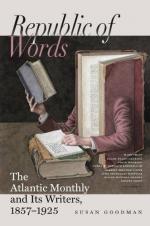He was apparently a little past the middle point of life, and entering on its shady afternoon. He was tall and well proportioned, and his features had the spare delicacy of the Italian outline. The round brow, fully developed in all the perceptive and aesthetic regions,—the keen eye, shadowed by long, dark lashes,—the thin, flexible lips,—the sunken cheek, where, on the slightest emotion, there fluttered a brilliant flush of color,—all were signs telling of the enthusiast in whom the nervous and spiritual predominated over the animal.
At times, his eye had a dilating brightness, as if from the flickering of some inward fire which was slowly consuming the mortal part, and its expression was brilliant even to the verge of insanity.
His dress was the simple, coarse, white stuff-gown of the Dominican friars, over which he wore a darker travelling-garment of coarse cloth, with a hood, from whose deep shadows his bright mysterious eyes looked like jewels from a cavern. At his side dangled a great rosary and cross of black wood, and under his arm he carried a portfolio secured with a leathern strap, which seemed stuffed to bursting with papers.
Father Antonio, whom we have thus introduced to the reader, was an itinerant preaching monk from the Convent of San Marco in Florence, on a pastoral and artistic tour through Italy.
Convents in the Middle Ages were the retreats of multitudes of natures who did not wish to live in a state of perpetual warfare and offence, and all the elegant arts flourished under their protecting shadows. Ornamental gardening, pharmacy, drawing, painting, carving in wood, illumination, and calligraphy were not unfrequent occupations of the holy fathers, and the convent has given to the illustrious roll of Italian Art some of its most brilliant names. No institution in modern Europe had a more established reputation in all these respects than the Convent of San Marco in Florence. In its best days, it was as near an approach to an ideal community, associated to unite religion, beauty, and utility, as ever has existed on earth. It was a retreat from the commonplace prose of life into an atmosphere at once devotional and poetic; and prayers and sacred hymns consecrated the elegant labors of the chisel and the pencil, no less than the more homely ones of the still and the crucible. San Marco, far from being that kind of sluggish lagoon often imagined in conventual life, was rather a sheltered hotbed of ideas,—fervid with intellectual and moral energy, and before the age in every radical movement. At this period, Savonarola, the poet and prophet of the Italian religious world of his day, was superior of this convent, pouring through all the members of the order the fire of his own impassioned nature, and seeking to lead them back to the fervors of more primitive and evangelical ages, and in the reaction of a worldly and corrupt Church was beginning to feel the power of that current which




